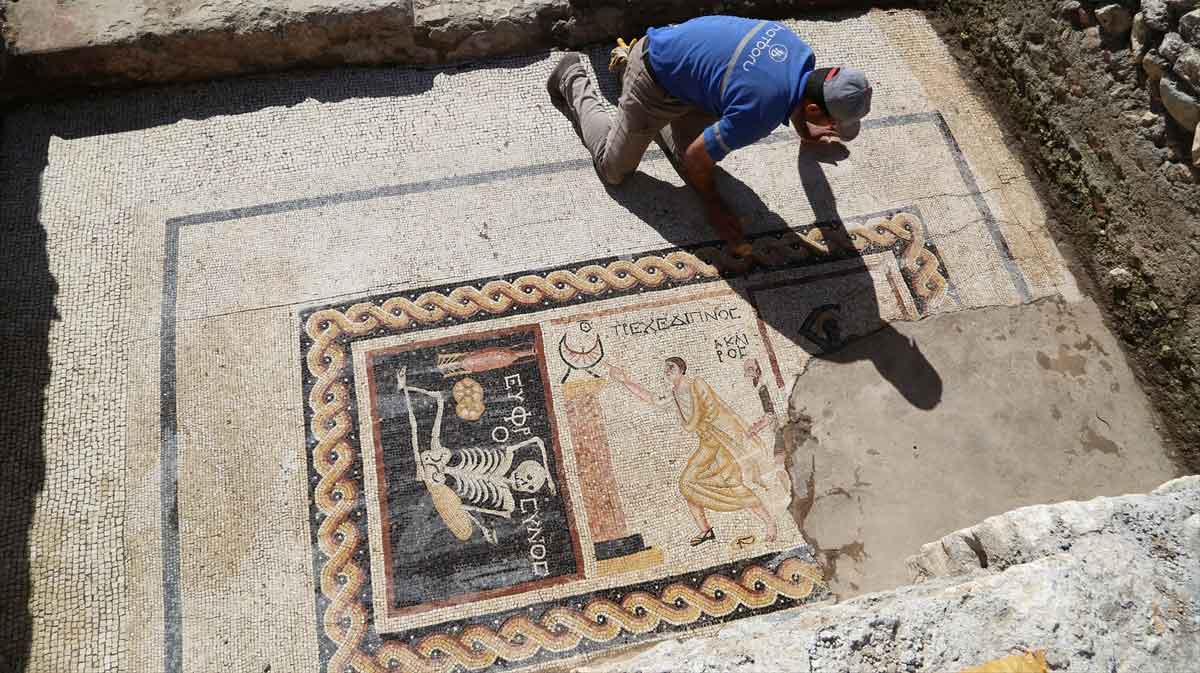- Details
- Hits: 3411
Perhaps the most famous alignment circle in the United States is the Cahokia Woodhenge near St. Louis constructed between 700-1400 CE by Cahokia Indigenous native Americans. But there were an estimated 10,000 other earthen mounds that once were scatter across the mid-west..
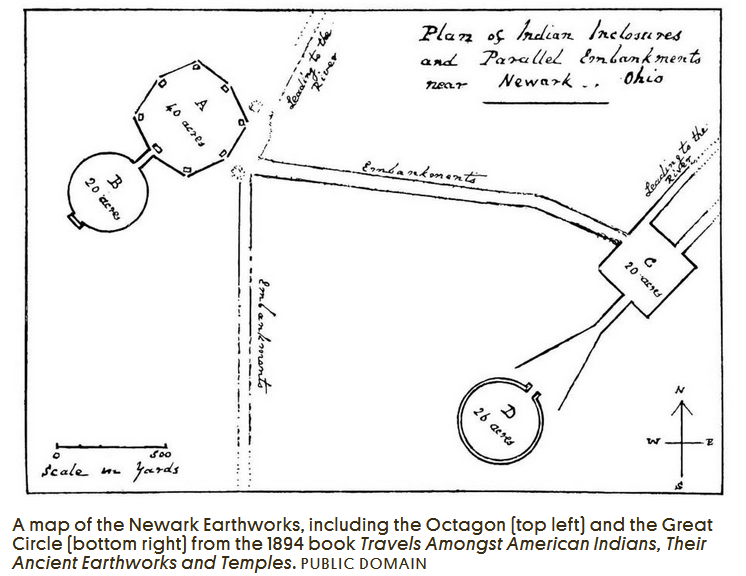 In an article from Atlas Obscura (https://www.atlasobscura.com/articles/octagon-earthworks-ohio) by Olivia Young on March 5, 2025:
In an article from Atlas Obscura (https://www.atlasobscura.com/articles/octagon-earthworks-ohio) by Olivia Young on March 5, 2025:
"Just outside of Ohio’s capital, a wall of earth rises five feet from the smooth ground in a perfect circle,1,000 feet (305m) wide. Standing inside that ring of mounded terra firma today, you can see the Moon rise right where the walls break and an ancient passageway leads to an enormous octagonal arena. Thousands of years ago, the Native Americans who built it would have been standing in that very spot, watching the same celestial scene." This is the position of the lunar standstill, the farthest north that the moon rises in the sky and occurs every lunar cycle of 18.6 years.
"The significance and sophistication of the Octagon Earthworks has been compared to that of Stonehenge and the pyramids in Giza. Despite that, the 2,000-year-old site was leased to a country club and used as a golf course for more than 100 years—up until January 1, 2025. After more than a decade of negotiating the Ohio History Connection (OHC) took over the lease and opened the sacred landmark to the public."
Dr. John Low, director of the Newark Earthworks Center at Ohio State Univ. noted that, "At the start of the 1800s, there were more than 40 tribes in what is now Ohio, including the Shawnee, Kickapoo, and Miami. By 1842, they had all been forcibly removed under the Indian Removal Act." But the indigenous people's vibrant culture and astronomical precision remains in their earthen mounds. Since 2023 this and other indigenous earthworks have been designated by UNESCO as a World Heritage Site (the Hopewell Ceremonial Earthworks), including the Octagon and Alignment Ring.
- Details
- Hits: 4670
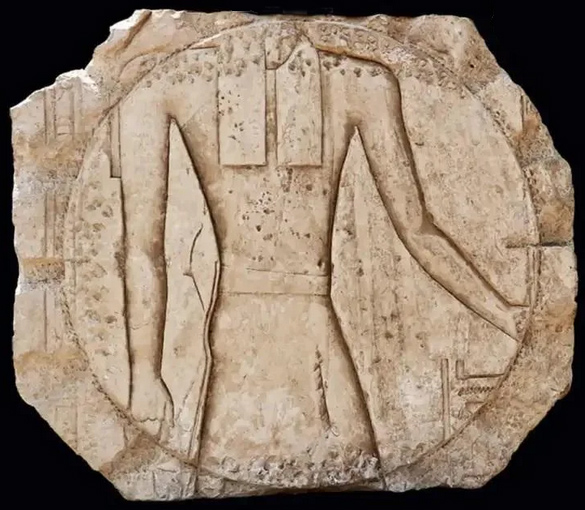 Dario Radley reports in Archaelogical News Online Magazine (Aug 24, 2024) that an ancient observatory from the 6th century BCE was found by the Egyptian Supreme Council of Antiquities at Tell El-Fara'in archaeological site.
Dario Radley reports in Archaelogical News Online Magazine (Aug 24, 2024) that an ancient observatory from the 6th century BCE was found by the Egyptian Supreme Council of Antiquities at Tell El-Fara'in archaeological site.
“It highlights the advanced astronomical knowledge of the ancient Egyptians, including their ability to determine the solar calendar and significant religious and agricultural dates,” Dr. Mohamed Ismail Khaled, Secretary-General of the Supreme Council of Antiquities, told Ahram Online.
Archaeological News Online further reported: One of the key findings at the site is an inclined stone sundial, known as a shadow clock, which was used to measure time based on the sun’s position. This sundial consists of a straight row of limestone slabs, approximately 4.80 meters long, with several vertical and horizontal blocks that may have been used to measure the angle and shadow of the sun throughout the day. Dr. Ayman Ashmawy, head of the Egyptian Antiquities Sector at the Supreme Council of Antiquities, described this sundial as one of the most significant artifacts found, illustrating the Egyptians’ skill in timekeeping and their understanding of solar movements.
Read the full article at:https://archaeologymag.com/2024/08/astronomical-observatory-discovered-in-kafr-el-sheikh/
- Details
- Hits: 11527
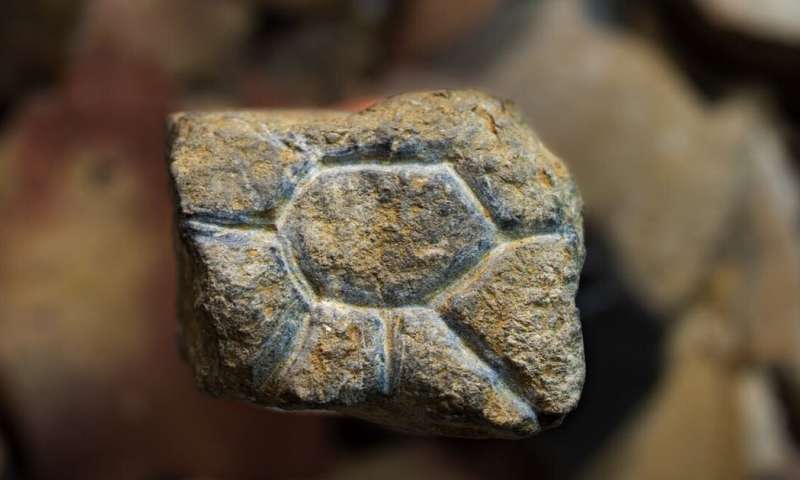 Photo Credit: Andrew Thompson Photo Credit: Andrew Thompson |
Archaeologists have found two miniature stone engravings in a cave on the island of Sulawesi in Indonesia. One plaquette appears to be a sunburst, the other an ibex like animal, the anoa. These pocket-sized carvings dating back between 14,000 and 26,000 years. Elsewhere in Sulawesi the oldest cave art dating to 44,000 years ago was recently discovered, dispelling the Euro-centric notion of Pleistocene art.
Examining the incisions cut into the ancient flowstone, the Sunburst hexegon outline was carved starting in the photo from upper left, with continuing connecting lines done clockwise. Then the 7 rays were added. Small traces of a red mineral (perhaps red ochre pigment) exist in some of the sunburst cuts, possibly indicating that the sun was enhanced in a beautiful red color. Before this discovery the oldest known depiction of the sun was from the Nebra sky disk found in Germany and fabricated of metal 3,600 years ago, rivaling Pharaoh Akenaten who built a whole city to the glory of the sun (Aten) 3,365 years ago. These are recent times compared to the sunburst.
The archaeology team was lead by Michelle C. Langley of the Australian Research Centre for Human Evolution, Griffith University, with associates at Arkeologi Nasional (ARKENAS), Jakarta, Balai Arkeologi Sulawesi Selatan and Balai Pelestarian Cagar Budaya in Makassar. They report in Nature Human Behaviour "... the discovery of two small stone ‘plaquettes’ incised with figurative imagery dating to 26–14 ka from Leang Bulu Bettue, Sulawesi. [The pocket-art was discovered in a cave and rockshelter complex of Leang Bulu Bettue (4° 59' 31.18" S, 119° 40' 5.53" E) situated at the foot of a limestone tower in the Maros-Pangkep karst area.] These new findings, together with the recent discovery of rock art dating to at least 40 ka in this same region, overturns the long-held belief that the first H. sapiens of Southeast Asia–Australasia did not create sophisticated art and further cements the importance of this behaviour for our species’ ability to overcome environmental and social challenges."
The artefacts reported here are currently curated at the Australian Research Centre for Human Evolution, Griffith University, Nathan, Australia. They will return to Indonesia at the conclusion of the project where they will be given accession numbers and be curated in Makassar by Balai Arkeologi Sulawesi Selatan.
Read more at:
- Details
- Hits: 17086
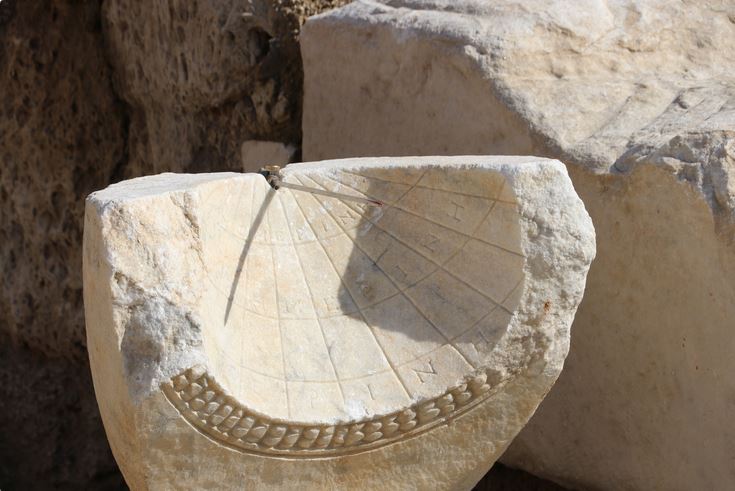 Several years ago in 2017 archaeologists found a rare hemicyclium sundial. Now another hemicyclium in excellent condition has been unearthed in Turkey's city of Denizli. Celal Şimşek, chief archaeologist at Denizli's Pamukkale University, calls it "unique". A better word is rare. Less than a hundred examples of this type of Hellenistic sundial have survived. It was found in the ancient city of Laodicea about 370 miles south of Istanbul. The sundial seems to have come from the archaeological site of one of the temples. As reported in the Daily Sabah, "Among the rare, largely preserved buildings in the city are the largest ancient stadium in Turkey, a theater and a sacred agora." The hemicyclium of pink marble has an outer edge decorated in foliage while the interior hemisphere has the traditional Greek names of the seasons. Hour lines deliniate the time. Almacantor lines show the solstices and a great circle marks the equinox. In AA Photo of the sundial at right, a needle gnomon has been restored to show how the sundial casts a shadow. Time and season are read at the gnomon shadow's tip.
Several years ago in 2017 archaeologists found a rare hemicyclium sundial. Now another hemicyclium in excellent condition has been unearthed in Turkey's city of Denizli. Celal Şimşek, chief archaeologist at Denizli's Pamukkale University, calls it "unique". A better word is rare. Less than a hundred examples of this type of Hellenistic sundial have survived. It was found in the ancient city of Laodicea about 370 miles south of Istanbul. The sundial seems to have come from the archaeological site of one of the temples. As reported in the Daily Sabah, "Among the rare, largely preserved buildings in the city are the largest ancient stadium in Turkey, a theater and a sacred agora." The hemicyclium of pink marble has an outer edge decorated in foliage while the interior hemisphere has the traditional Greek names of the seasons. Hour lines deliniate the time. Almacantor lines show the solstices and a great circle marks the equinox. In AA Photo of the sundial at right, a needle gnomon has been restored to show how the sundial casts a shadow. Time and season are read at the gnomon shadow's tip.
Read more at: https://www.dailysabah.com/life/history/2000-year-old-sundial-unearthed-in-southern-turkeys-denizli
ADDENDUM FROM SUNDIAL DIGEST - 10 April 2020
I would like to add two arguments to the questions [of the sundial's age] under discussion:
1. Prof. Şimşek said: “On the North Parados passage in the Western Theater, which dates back to the Hellenistic Era, in the ancient city we have found a spherical sundial facing south, which we believe to be 2,020 years old.
This is a kind of conclusion which does not help by dating the dial. A comparison with similar specimens reveals that it was probably done around 200 – 400 CE.
2. “Inscribed on the dial are the Greek word ‘Ksimerini’, or winter on the upper part; ‘Isimerini’, or solstice, which denotes the equality of day and night in the middle; and ‘Terini’, or summer in the bottom.”
I read (ΤΡΟΠH) ΧΕ(Ι)ΜΕΡΙΝH / IΣΗΜΕΡΙΝH / (ΤΡΟΠH) ΘΕΡΙΝH.
These are the names of the solstices and the equinoxes. What is conspicuous is the missing of I in χειμερινή (it should be written with diacritic signs). That is another strong argument that it was done in the Roman era.
With best wishes
Karlheinz Schaldach
- Details
- Hits: 13065
We've reported on ancient mosaics from Turkey showing sundials (Antioch Mosaic Sundial - 2016). Now from the Ministry of Sciences and Higher Education in Poland ( Archaeology News - Ancient Sundial and Science in Poland ) another ancient mosaic sundial has been discovered:
Sundial in the Madaba Map, a great mosaic located in Jordan. The sundial is located next to the gate on the left. Credit Wikipedia/public domain.
Professor Marek T. Olszewski from the University of Warsaw was re-examining a number of mosaics dating back to the 2nd century AD when he made his startling discovery.
One of the mosaics from the 6th century AD which was discovered by the Gate of Damascus in Jerusalem, Olszewski noticed that between a richly dressed women, a mysterious object is visible, which scientists at the beginning of the 20th century described as an oil lamp or column.
Olszewski said: ”After careful analysis and comparison with a sundial discovered during excavations, I came to the conclusion that this mosaic and other ones similar to it depict sundials....
Another sundial "tracked" by the Polish researcher is located in a wall mosaic in Santa Cecilia in Trastevere church in Rome. This mosaic was created during the time of Pope Paschal I (817-824).
Prof. Olszewski also noticed a previously unknown sundial in the Madaba Map - a huge floor mosaic, which is currently stored in the church of St. George in Madaba, Jordan. It shows a map of the Middle East from the Byzantine period. This is the oldest cartographic depiction of the Holy Land, including Jerusalem and dates back to the 6th century AD.
Yet another depiction of a sundial comes from Tarsus (Mersin) in Turkey, where a figural mosaic (ca. 2nd-3rd century AD) shows a sundial on a column and a crow sitting on it. A man tries to scare off the bird by throwing a pouch at it (crow was a symbol of a bad omen).
Professor Olszewski has now discovered eight previously unknown sundials in the designs, taking the total number known to 15.
- Details
- Hits: 14708
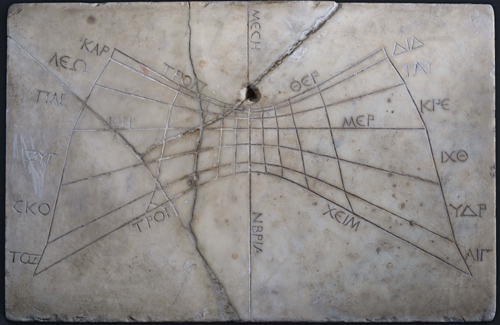
Horizontal Gnomonic Dial (Inv. 3075)
by permission
Museo Archeologico Nazionale di Napoli
|
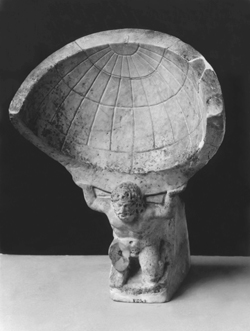
Statuette of Atlas Bearing a Hemispherical Sundial
by permission
Sir John Soane's Museum, London
|
The Institute for the Study of the Ancient World (15 East 84th Street in New York) is hosting an exhibition "Time and Cosmos in Greco-Roman Antiquity" open to the public from now until April 23, 2017. From their on-line invitation, "This exhibition aims to explore the ways that time was organized and kept track of in the Greco-Roman world, and how it was conceived in relation to the Cosmos. The objects displayed include artifacts illustrating the technology of ancient time-reckoning and the perception, visualization, and social role of time and cosmos..." This is exemplified by a wonderful horizontal gnomonic sundial using a vertical gnomon shown at left. It was found at Pompeii around 1865 and became part of the Museo Archeologico Nazionale di Napoli in 1867. "Despite the fact that it was found in Italy, the inscriptions on it are in Greek, perfhaps reflecting the status of Greek as the langauage of science in antiquity. The summer and winter tropics (solstices), equinox, and seasons are reasonably declined. The hour lines however reflect temporal hours rather than the hour angles we would draw todayl.
- Details
- Hits: 24587
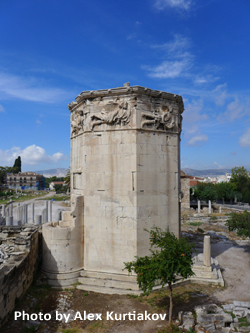 In the old Roman Agora on the slope of Athen's ancient Acropolis hill is the Tower ofWinds. Today, completing two years of restoration, the interior was re-opened to the public this summer in August, 2016. The Tower had been closed for the last 200 years. The story of the Tower starts in the first century, BCE, probably during the reign of Julius Caesar.
In the old Roman Agora on the slope of Athen's ancient Acropolis hill is the Tower ofWinds. Today, completing two years of restoration, the interior was re-opened to the public this summer in August, 2016. The Tower had been closed for the last 200 years. The story of the Tower starts in the first century, BCE, probably during the reign of Julius Caesar.
The Tower was designed by Andronikos Kyrrhestos (Andronicus of Cyrrhus), an astronomer and maker of celestial instruments. Andronicus constructed a white marble sundial for the sanctuary of Poseidon and Amphitrite on the island of Tinos. The sundial becamse so famous that Andronicus was invited to Athens where he erected the magnificent 14 meter Tower called the Aerides (the Winds) . It was built on the eastern side of the Roman Agora in Athens and meant to have utilitarian value. "No one knows who funded its lavish construction - the octagonal monument is made almost entirely of Pentelic marble, the same used for the Parthenon and rarely found in buildings other than temples," said Stelios Daskalakis, head conservator.
Atop of the octogon tower now rests the fully-preserved roof made of 24 marble slabs, resting on a Corinthian capital. Once a bronze statue of Trition, the god of the sea, was set on the roof to turn in the wind as a weather indicator. By night, water flowed through a hydro-mechanical system designed by Andronicus from a cylinder inside the Tower. The water level lead to an exterior indicator creating a night time clock or clepsydra. During the day the Tower was a public time teller with eight sundials.
- Details
- Hits: 26553
|
|
The Daily Sabah reports a 2,400 year old mosaic discovered during excavations in Turkey's southern Hatay provice that shows a skeleton that according to archeologist Demet Kara fromthe Hatay Archeology Museum has an inscription that translates from ancient Greek to say "Be cherrful, and live your life."
Perhaps more interesting to sundialists is the mosaic further right. It is of a Roman attending the bath. Demet Kara explains, "...there is a sundial and a young clothed man run[s] towards it with a bare-headed butler behind. The sundial is between 9 and 10 am. 9am is the bath time in the Roman period. He has to arrive at supper at 10am. Unless he can, it is not well received. There is writing on the scene that reads he is late for supper and writing about time on the other."
Kara added, "[This is] a unique mosaic in Turkey. There is a similar mosaic in Italy but this one is much more comprehensive. It is important for the fact that it dates back to the third century BCE...Antiocheia was a very important, rich city. There were mosaic schools and mints in the city. The ancient city of Zeugma in [the southeastern province of] Gaziantep might have been established by people who were trained here. Antiocheia mosaics are world famous."
- Details
- Hits: 17468
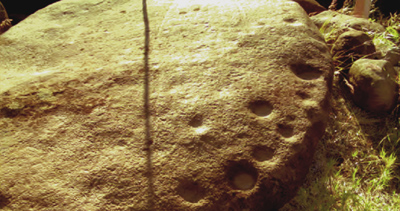
Kānaloa Stone Shadow Alignment
Photo: Kaho'olawe Island Reserve Commission
|
On Kaho'olawe, the smallest island of the Hawaiian island chain only 7 miles from Maui, sits an endangered and sacred rock, the Kānaloa, with petroglyphs and a row of 32 cupules (man-made depressions) along one edge. “It has significant celestial alignments with the rising and setting of the sun,” said Michael Naho'opi'i, Executive Director of the Kaho'olawe Island Reserve Commission (KIRC). It appears that there is a relationship between the shadow of a stick held vertically along lines etched in the stone and the cupules.
Documented as Site 110 feature BU, the Kānaloa stone is relatively flat and rests on a natural pedestal that when tapped, resonates with a bell-like ring. But its petroglyphs and alignment cups may soon topple into a nearby and ever growing ravine. In 2010 the Commission approved "The Cultural Use Plan: Kūkulu Ke Ea A Kānaloa" with one of the recommendations to preserve and stabilize the stone. The first phase of the plan has been to document the stone's celestial alignments and quantify the erosion forces acting on its base.

